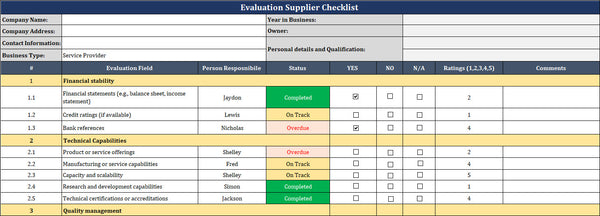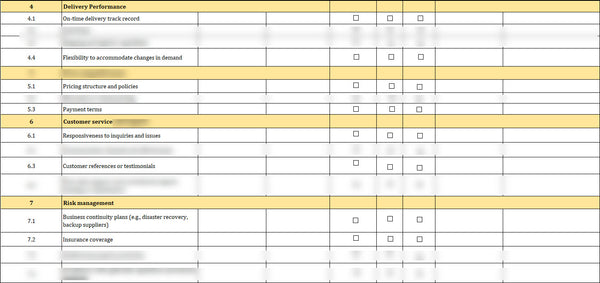ISO 9001 Evaluation Supplier Checklist Template
Ensuring consistent and high-quality products and services in quality management is paramount to an organization's success. Organizations often collaborate with suppliers who provide critical components, materials, or services to achieve this. However, maintaining the desired level of quality across the entire supply chain can be challenging. This is where ISO 9001, a globally recognized standard for quality management systems, comes into play.

ISO 9001 strongly emphasises effective supplier management as a means to uphold and enhance the quality of an organization's offerings. Central to this approach is the concept of evaluating supplier checklists – a systematic process that helps organizations assess their suppliers' performance, capabilities, and reliability. This article will delve into the significance of evaluating supplier checklists within the ISO 9001 framework.
Key Components of Evaluation Supplier Checklist
Key Components of Evaluation Supplier Checklist for ISO 9001
When evaluating and selecting suppliers for your organization, it's crucial to have a systematic approach. ISO 9001, the international standard for quality management systems, provides guidelines for this process. By implementing a comprehensive supplier evaluation checklist, you can ensure that your suppliers meet the necessary standards and contribute to your organization's success. We will discuss the key components of an evaluation supplier checklist for ISO 9001.
1. Financial Stability: Financial stability is one of the critical factors to consider when evaluating suppliers. It involves assessing their financial health, credit ratings, and ability to meet contractual obligations. A financially stable supplier can be relied upon to deliver quality goods and services consistently.
2. Technical Capabilities: Technical capabilities refer to the supplier's ability to meet your organization's requirements. This includes evaluating their equipment, technology, certifications, and expertise. Ensuring that the supplier has the skills and resources to meet your quality expectations is vital.
3. Quality Management: ISO 9001 emphasizes the importance of a robust quality management system (QMS). Evaluate your supplier's QMS, including their quality planning, control, and improvement processes. Ensure that they have appropriate quality certifications such as ISO 9001.
4. Delivery Performance: Meeting delivery deadlines is crucial to avoid disruptions in production or service delivery. Assess the supplier's track record for on-time delivery and their processes for managing and communicating potential delays or disruptions.
5. Price Competitiveness: While price should not be the sole determining factor, evaluating the supplier's pricing structure is important. Compare their prices with other suppliers in the market to ensure competitiveness. Ensure you're getting the best value for your money without compromising quality.
6. Customer Service and Support: Good customer service and support are essential in maintaining a healthy supplier relationship. Assess the supplier's responsiveness, communication, and willingness to promptly address any concerns or issues. Vital customer service ensures effective collaboration and problem-solving.
7. Risk Management: Identifying and managing supply chain risks is crucial for smooth operations. Evaluate how your supplier manages risks, such as potential disruptions, quality issues, and compliance with regulations. Assess their contingency plans and their ability to mitigate risks effectively.
8. Stability and Corporate Social Responsibility: A stable supplier that aligns with your organization's values is more likely to provide consistent quality and adhere to ethical standards. Evaluate their stability, longevity in the market, and engagement in corporate social responsibility practices. This includes their commitment to sustainability, ethical sourcing, and fair labor practices.
9. Geographic Location: Consider the location of your supplier, your organization and your customers. Proximity can impact lead times, transportation costs, and overall efficiency. Assess whether the supplier's location aligns with your strategic goals and logistical requirements.
10. Cultural Fit: Lastly, cultural fit is an essential consideration when selecting suppliers. Evaluate the supplier's corporate culture values and how well they align with your organization's culture. A good cultural fit can lead to smoother collaboration and better overall performance.
A robust evaluation supplier checklist is vital for selecting suppliers that meet the requirements of ISO 9001 and contribute to the success of your organization. By considering the key components mentioned above, you can ensure your suppliers' quality, reliability, and performance, leading to improved operational efficiency and customer satisfaction.

Benefits of Practical Supplier Evaluation
Practical supplier evaluation plays a crucial role in ISO 9001 and offers a range of benefits to organizations that implement it. Here are some of the key benefits:
1. Improved Product Quality: By thoroughly evaluating suppliers' capabilities and quality management practices, organizations can ensure that the products or services they receive meet or exceed the required quality standards. This, in turn, contributes to better overall product quality for the organization.
2. Risk Reduction: Supplier evaluation helps identify potential risks associated with suppliers' performance, quality, financial stability, and other factors. By assessing these risks, organizations can proactively implement mitigation strategies and minimize disruptions to their supply chain.
3. Enhanced Reliability: Engaging with reliable suppliers who consistently meet their commitments and deliver on time fosters a more reliable supply chain. This reduces the chances of production delays and helps maintain consistent product availability.
4. Cost Savings: Working with high-quality suppliers can lead to fewer defects, rework, and product failures. This reduces the need for costly corrective actions and improves overall operational efficiency, ultimately leading to cost savings.
5. Stronger Relationships: Effective supplier evaluation encourages open communication and collaboration between organizations and their suppliers. Building solid relationships with suppliers can lead to better understanding, shared goals, and a more cooperative approach to problem-solving.
6. Compliance Assurance: Supplier evaluation helps suppliers meet regulatory requirements and industry standards. This compliance assurance is essential for maintaining legal and ethical practices throughout the supply chain.
7. Continuous Improvement: Through regular supplier evaluations, organizations can identify areas where their suppliers can improve. Encouraging suppliers to adopt continuous improvement initiatives benefits both parties and can lead to more innovative and efficient processes.
8. Faster Issue Resolution: Supplier evaluation includes monitoring supplier performance and addressing any issues promptly. This proactive approach helps resolve problems faster and prevents minor issues from escalating into more significant concerns.
9. Strategic Alignment: Supplier evaluation allows organizations to assess whether their suppliers' capabilities align with their strategic goals. This ensures that suppliers are chosen based on immediate needs and with an eye towards long-term objectives.
10. Supplier Development: Effective evaluation can highlight areas where suppliers may need assistance or training. Organizations can invest in supplier development programs to enhance their suppliers' capabilities and align them with the organization's requirements.
11. Data-Driven Decision-Making: Supplier evaluation provides organizations with data and insights to make informed decisions about supplier selection, improvement strategies, and overall supply chain management.
12. Customer Satisfaction: High-quality suppliers contribute to better products and services, increasing customer satisfaction. Meeting customer expectations consistently strengthens the organization's reputation and market position.
Incorporating supplier evaluation practices by ISO 9001 guidelines ensures that organizations maintain a reliable and effective supply chain, promoting overall quality management and customer satisfaction.
Conclusion
By aligning supplier evaluation practices with IS 9001, organizations can realize benefits such as improved product quality, reduced risks, better supplier relationships, cost savings, and customer satisfaction. Integrating an effective supplier evaluation process ultimately contributes to the organization's commitment to continuous improvement, excellence, and adherence to international quality standards.

